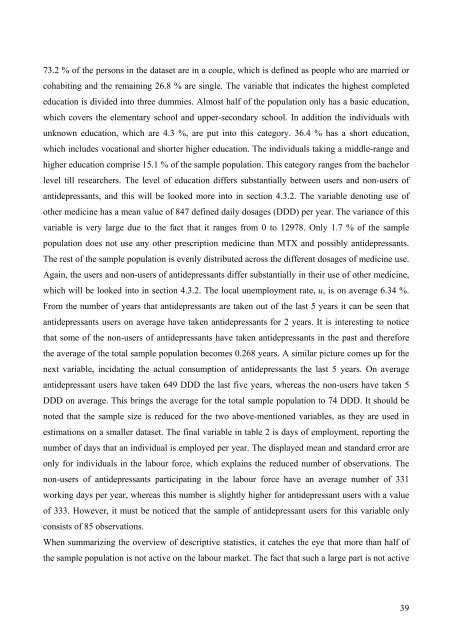An Analysis on Danish Micro Data - School of Economics and ...
An Analysis on Danish Micro Data - School of Economics and ...
An Analysis on Danish Micro Data - School of Economics and ...
You also want an ePaper? Increase the reach of your titles
YUMPU automatically turns print PDFs into web optimized ePapers that Google loves.
73.2 % <strong>of</strong> the pers<strong>on</strong>s in the dataset are in a couple, which is defined as people who are married or<br />
cohabiting <strong>and</strong> the remaining 26.8 % are single. The variable that indicates the highest completed<br />
educati<strong>on</strong> is divided into three dummies. Almost half <strong>of</strong> the populati<strong>on</strong> <strong>on</strong>ly has a basic educati<strong>on</strong>,<br />
which covers the elementary school <strong>and</strong> upper-sec<strong>on</strong>dary school. In additi<strong>on</strong> the individuals with<br />
unknown educati<strong>on</strong>, which are 4.3 %, are put into this category. 36.4 % has a short educati<strong>on</strong>,<br />
which includes vocati<strong>on</strong>al <strong>and</strong> shorter higher educati<strong>on</strong>. The individuals taking a middle-range <strong>and</strong><br />
higher educati<strong>on</strong> comprise 15.1 % <strong>of</strong> the sample populati<strong>on</strong>. This category ranges from the bachelor<br />
level till researchers. The level <strong>of</strong> educati<strong>on</strong> differs substantially between users <strong>and</strong> n<strong>on</strong>-users <strong>of</strong><br />
antidepressants, <strong>and</strong> this will be looked more into in secti<strong>on</strong> 4.3.2. The variable denoting use <strong>of</strong><br />
other medicine has a mean value <strong>of</strong> 847 defined daily dosages (DDD) per year. The variance <strong>of</strong> this<br />
variable is very large due to the fact that it ranges from 0 to 12978. Only 1.7 % <strong>of</strong> the sample<br />
populati<strong>on</strong> does not use any other prescripti<strong>on</strong> medicine than MTX <strong>and</strong> possibly antidepressants.<br />
The rest <strong>of</strong> the sample populati<strong>on</strong> is evenly distributed across the different dosages <strong>of</strong> medicine use.<br />
Again, the users <strong>and</strong> n<strong>on</strong>-users <strong>of</strong> antidepressants differ substantially in their use <strong>of</strong> other medicine,<br />
which will be looked into in secti<strong>on</strong> 4.3.2. The local unemployment rate, u, is <strong>on</strong> average 6.34 %.<br />
From the number <strong>of</strong> years that antidepressants are taken out <strong>of</strong> the last 5 years it can be seen that<br />
antidepressants users <strong>on</strong> average have taken antidepressants for 2 years. It is interesting to notice<br />
that some <strong>of</strong> the n<strong>on</strong>-users <strong>of</strong> antidepressants have taken antidepressants in the past <strong>and</strong> therefore<br />
the average <strong>of</strong> the total sample populati<strong>on</strong> becomes 0.268 years. A similar picture comes up for the<br />
next variable, incidating the actual c<strong>on</strong>sumpti<strong>on</strong> <strong>of</strong> antidepressants the last 5 years. On average<br />
antidepressant users have taken 649 DDD the last five years, whereas the n<strong>on</strong>-users have taken 5<br />
DDD <strong>on</strong> average. This brings the average for the total sample populati<strong>on</strong> to 74 DDD. It should be<br />
noted that the sample size is reduced for the two above-menti<strong>on</strong>ed variables, as they are used in<br />
estimati<strong>on</strong>s <strong>on</strong> a smaller dataset. The final variable in table 2 is days <strong>of</strong> employment, reporting the<br />
number <strong>of</strong> days that an individual is employed per year. The displayed mean <strong>and</strong> st<strong>and</strong>ard error are<br />
<strong>on</strong>ly for individuals in the labour force, which explains the reduced number <strong>of</strong> observati<strong>on</strong>s. The<br />
n<strong>on</strong>-users <strong>of</strong> antidepressants participating in the labour force have an average number <strong>of</strong> 331<br />
working days per year, whereas this number is slightly higher for antidepressant users with a value<br />
<strong>of</strong> 333. However, it must be noticed that the sample <strong>of</strong> antidepressant users for this variable <strong>on</strong>ly<br />
c<strong>on</strong>sists <strong>of</strong> 85 observati<strong>on</strong>s.<br />
When summarizing the overview <strong>of</strong> descriptive statistics, it catches the eye that more than half <strong>of</strong><br />
the sample populati<strong>on</strong> is not active <strong>on</strong> the labour market. The fact that such a large part is not active<br />
39
















